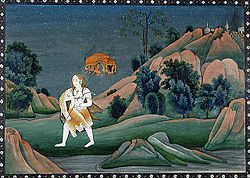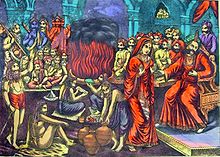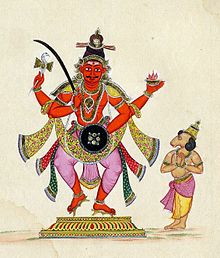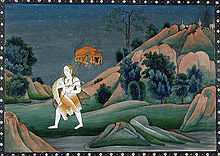- Dakshayani
-
Dakshayani (Sati) 
Devanagari दाक्षायणी (सती) Sanskrit Transliteration Dākshāyani (Satī) Consort Shiva Dākshāyani (Devanagari: दाक्षायणी) or Satī (सती) is a Hindu Goddess of marital felicity and longevity. She is worshipped particularly by Hindu women to seek the long life of their husbands. An aspect of Devi, Dākshāyani is the first consort of Shiva, the second being Pārvatī, the reincarnation of Dākshāyani herself.
In Hindu legend, both Dākshāyani and Pārvatī successively plays the role of bringing Shiva away from ascetic isolation into creative participation in the world.[1] The act of Sati, in which a Hindu widow immolates herself on her husband's funeral pyre as a final and consummate act of loyalty and devotion, is patterned after the deed committed by this Goddess to uphold the honour of her husband.[2]
Dākshāyani is also known as Satī, Gaurī, Umā, Aparnā, Sivakāmini and by over a thousand other names; a listing is to be found in the Lalithā Sahasranāmam
Contents
Legend
The Goddess Umā, a personification of the divine Omkara and embodiment of Prakrti (understood as Nature or creativity), took human birth at the bidding of Brahmā. Umā was born as a daughter of Daksha Prajāpati and his wife Prasuti. Daksha was a son of Brahmā himself, and a great king and magnate in his own right. The girl was named Gaurī, "the turmeric-hued one," since she was of the fair, golden complexion of auspicious turmeric. As the daughter of Daksha, she is also known as Dākshāyani.
Marriage with Shiva
In bidding the Goddess Umā to take human birth, Brahmā's design was that she should please Shiva with humble devotions and wed him. It was natural that Gaurī, even as a child, adored the tales and legends associated with Shiva and grew up an ardent devotee. As Gaurī grew to womanhood, the idea of marrying anyone else, as intended by her father, became anathema to her. Every proposal from valiant and rich kings made her crave evermore the ascetic of Kailāsa, the God of Gods, who bestowed all on this world and himself foreswore all.
To win the regard of the ascetic Shiva, the daughter of king Daksha forsook the luxuries of her father's palace and retired to a forest, there to devote herself to austerities and the worship of Shiva. So rigorous were her penances that she gradually renounced food itself, at one stage subsisting on one bilva leaf a day, and then giving up even that nourishment; this particular abstinence earned her the sobriquet Aparnā. Her prayers finally bore fruit when, after testing her resolve, Shiva finally acceded to her wishes and consented to make her his bride.
An ecstatic Gaurī returned to her father's home to await her bridegroom, but found her father less than elated by the turn of events. The wedding was however held in due course, and Gaurī made her home with Shiva in Kailāsa. Daksha, depicted in legend as an arrogant king, did not get on with his renunciate son-in-law and basically cut his daughter away from her natal family.
Daksha's arrogance
Daksha once organized a grand yagna to which all the Gods were invited, with the exception of Gaurī and Shiva. Wanting to visit her parents, relatives and childhood friends, Gaurī sought to rationalize this omission. She reasoned within herself that her parents had neglected to make a formal invitation to them only because, as family, such formality was unnecessary; certainly, she needed no invitation to visit her own mother and would go anyway. Shiva sought to dissuade her, but she was resolved upon going; he then provided her with an escort of his ganas and bid her provoke no incident.
Self-immolation
Gaurī was received coldly by her father. They were soon in the midst of a heated argument about the virtues (and alleged lack thereof) of Shiva. Every passing moment made it clearer to Gaurī that her father was entirely incapable of appreciating the many excellent qualities of her husband. The realization then came to Gaurī that this abuse was being heaped on Shiva only because he had wed her; she was the cause of this dishonour to her husband. She was consumed by rage against her father and loathing for his mentality.
Calling up a prayer that she may, in a future birth, be born the daughter of a father whom she could respect, Dākshāyani invoked her yogic powers and immolated herself.
Shiva's rage
Shiva sensed this catastrophe, and his rage was incomparable. He created Virabhadra and Bhadrakāli, two ferocious creatures who wreaked havoc and mayhem on the scene of the horrific incident. Nearly all those present were indiscriminately felled overnight. Daksha himself was decapitated.
According to some traditions, it is believed that an angry Shiva performed the fearsome and awe-inspiring Tāndava dance with Gaurī's charred body on his shoulders. During this dance, Gaurī's body came apart and the pieces fell at different places on earth. According to another version, Shiva placed Gaurī's body on his shoulder and ran about the world, crazed with grief. The Gods called upon Lord Vishnu to restore Shiva to normalcy and calm. Vishnu used his Sudarshana Chakram to dismember Gaurī's lifeless body, following which Shiva regained his equanimity. Both versions state that Gaurī's body was thus dismembered into 51 pieces which fell on earth at various places. Several different listings of these 51 holy places, known as Shakti Peethas, are available; some of these places have become major centers of pilgrimage as they are held by some sects of Hinduism to be particularly holy.
After the night of horror, Shiva, the all-forgiving, restored all those who were slain to life and granted them his blessings. Even the abusive and culpable Daksha was restored both his life and his kingship. His decapitated head was substituted for that of a goat. Having learned his lesson, Daksha spent his remaining years as a devotee of Shiva.
Aftermath
Dākshāyani was reborn as Pārvatī, daughter of Himavan, king of the mountains, and his wife, the apsara Menā. This time, she was born the daughter of a father whom she could respect, a father who appreciated Shiva ardently. Naturally, Pārvatī sought and received Shiva as her husband. This legend appears in detail in Tantra literature, in the Puranas and in Kālidāsa's lyrical Kumārasambhavam, an epic that deals primarily with the birth of Subrahmanya.
See also
- Sati (practice)
- Hindu deities
- List of Hindu deities
- List of Hinduism-related articles
References
- ^ Kinsley, David (1987, reprint 2005). Hindu Goddesses: Visions of the Divine Feminine in the Hindu Religious Tradition, Delhi: Motilal Banarsidass, ISBN 81-208-0394-9, p.38
- ^ Kinsley, David (1987, reprint 2005). Hindu Goddesses: Visions of the Divine Feminine in the Hindu Religious Tradition, Delhi: Motilal Banarsidass, ISBN 81-208-0394-9, p.35
Hindu deities and texts Gods 
Goddesses Texts Categories:- Forms of Parvati
- Shaktism
- Hindu goddesses
- Sanskrit words and phrases
Wikimedia Foundation. 2010.



